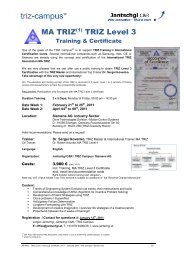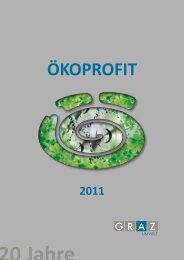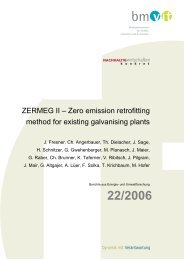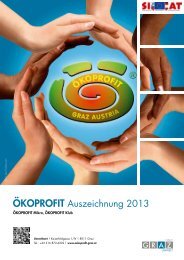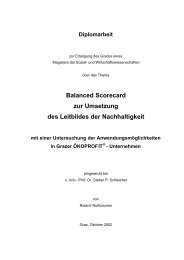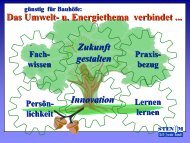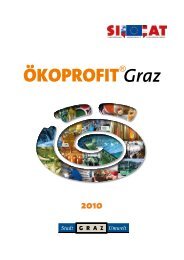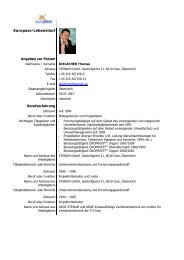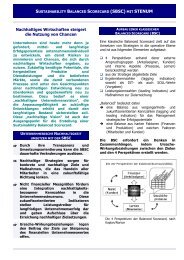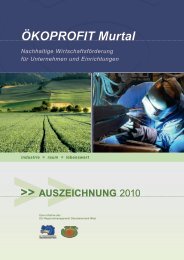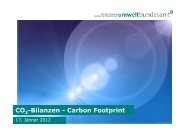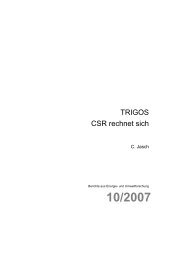Promoting Resource Efficiency in Small & Medium size ... - UNEP
Promoting Resource Efficiency in Small & Medium size ... - UNEP
Promoting Resource Efficiency in Small & Medium size ... - UNEP
Create successful ePaper yourself
Turn your PDF publications into a flip-book with our unique Google optimized e-Paper software.
Figure 13: Life cycle analysis of a product shows material and energy flows of material extraction, process<strong>in</strong>g, manufactur<strong>in</strong>g, use and disposal as a basis to<br />
develop <strong>Resource</strong> <strong>Efficiency</strong> strategies. 15<br />
120<br />
100<br />
80<br />
60<br />
40<br />
20<br />
0<br />
Production Distribution Use Disposal<br />
Figure 14: LCA of a wash<strong>in</strong>g mach<strong>in</strong>e 16<br />
2.3 Life cycle analysis<br />
Energy Consumption<br />
Air Pollution<br />
Water Poluttion<br />
Solid Waste<br />
Water Consumption<br />
<strong>Resource</strong> <strong>Efficiency</strong> <strong>in</strong>volves the consideration of all the stages of the<br />
life cycle of a product <strong>in</strong>clud<strong>in</strong>g extraction of resources, production, the<br />
use of the product and disposal or recycl<strong>in</strong>g.<br />
Fabrication of a product with m<strong>in</strong>imal use of resources <strong>in</strong>volves: reduc<strong>in</strong>g<br />
up-take of raw material, reus<strong>in</strong>g materials from other processes, recycl<strong>in</strong>g<br />
products <strong>in</strong>to new products and repair<strong>in</strong>g products <strong>in</strong>stead of replac<strong>in</strong>g<br />
them with new ones. To be effective, such considerations must be built<br />
<strong>in</strong>to <strong>in</strong>dustrial processes and the life cycle plann<strong>in</strong>g of a product.<br />
The product life cycle <strong>in</strong> Figure 13 is shown <strong>in</strong> five dist<strong>in</strong>ct phases,<br />
all of which <strong>in</strong>teract with the environment. Figure 13 also shows, as<br />
feedback loops, the potential for recycl<strong>in</strong>g, remanufactur<strong>in</strong>g and reuse.<br />
Reuse is the strategy that potentially has the lowest environmental<br />
impact, based on the fact that this <strong>in</strong>volves fewer processes; each stage<br />
absorbs energy and has an environmental impact.<br />
Depend<strong>in</strong>g on the type of product, major environmental and social<br />
impacts might orig<strong>in</strong>ate from different stages. With some materials<br />
such as copper or alum<strong>in</strong>ium, the extraction phase has the biggest<br />
impact because of the energy <strong>in</strong>tensity of this step. With batterypowered<br />
products the phase of use might have the biggest impact<br />
because of the use of consumable batteries, which are generally<br />
classified as hazardous waste. A car, for example, has equal energy<br />
consumption <strong>in</strong> production and use. The environmental impact of<br />
different phases for each product should be understood<br />
to identify the priority areas, to reduce the environmental<br />
impact and to <strong>in</strong>crease <strong>Resource</strong> <strong>Efficiency</strong>.<br />
Figure 14 shows a Life Cycle Assessment (LCA) of a wash<strong>in</strong>g<br />
mach<strong>in</strong>e <strong>in</strong> terms of the energy and water used, of the<br />
contribution to air and water pollution, and of solid waste.<br />
As you might expect, most of the environmental impact is<br />
dur<strong>in</strong>g use. You might have predicted that most of the solid<br />
waste impact would be the two stages of delivery (when<br />
the packag<strong>in</strong>g is removed and disposed of) and eventual<br />
end-of-life disposal. Whilst the solid waste levels are <strong>in</strong>deed<br />
significantly higher than other contributors at these stages,<br />
<strong>in</strong> fact they total less than 15% of the solid waste produced<br />
by the wash<strong>in</strong>g mach<strong>in</strong>e. Just th<strong>in</strong>k of the many packets of<br />
wash<strong>in</strong>g powder and other consumables that are thrown out dur<strong>in</strong>g<br />
the mach<strong>in</strong>e’s life. This illustrates that every aspect of use must be<br />
considered carefully and that the ‘system boundary’ must be drawn<br />
broadly enough to cover all relevant externalities.<br />
2.4 Indicators for <strong>Resource</strong> <strong>Efficiency</strong><br />
2.4.1 Dematerialisation: Material <strong>in</strong>tensity per unit<br />
of service<br />
As outl<strong>in</strong>ed <strong>in</strong> Agenda 21 of the United Nations Conference on<br />
Environmental and Development (UNCED) <strong>in</strong> Rio de Janeiro <strong>in</strong> 1992,<br />
there is a need for susta<strong>in</strong>ability <strong>in</strong>dicators to provide a solid basis for<br />
decision-mak<strong>in</strong>g and to measure progress.<br />
In 1992, Prof. Schmidt Bleek proposed the Material (<strong>in</strong>clud<strong>in</strong>g energy)<br />
Intensity Per unit of Service (utility or function) - the MIPS - as a measure<br />
for “estimat<strong>in</strong>g the ecological stress potential of goods and services<br />
from cradle to grave”. MIPS is computed <strong>in</strong> material <strong>in</strong>put per total<br />
unit of services delivered by the product over its entire useful life span<br />
(<strong>Resource</strong> extraction, manufactur<strong>in</strong>g, transport, packag<strong>in</strong>g, operat<strong>in</strong>g,<br />
reuse, recycl<strong>in</strong>g and remanufactur<strong>in</strong>g are accounted for, and so is the<br />
f<strong>in</strong>al waste disposal). From the material <strong>in</strong>puts of resource extraction,<br />
manufactur<strong>in</strong>g, transport, etc., the ‘ecological rucksack’ of a product or<br />
service is calculated. Ecological rucksack means the consumption of<br />
resources and energy dur<strong>in</strong>g the extraction of the resources <strong>in</strong> the ground<br />
and its process<strong>in</strong>g. 17<br />
15) Source: Mart<strong>in</strong> Tarr<br />
16) Source: Andrew Sweatman<br />
17) Schmidt-Bleek F., The Factor 10/MIPS-Concept, Bridg<strong>in</strong>g Ecological, Economic,<br />
and Social Dimensions with Susta<strong>in</strong>ability Indicators’, F., 2000<br />
15



